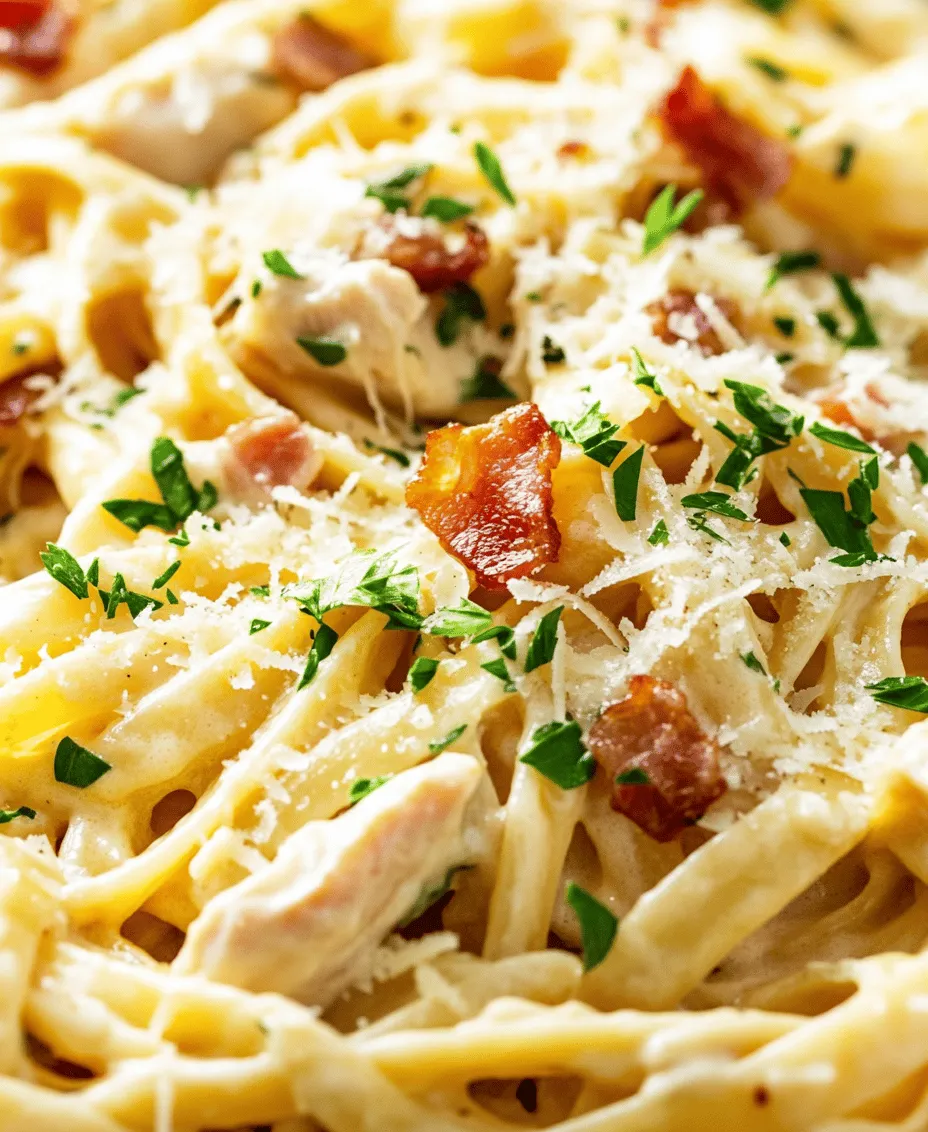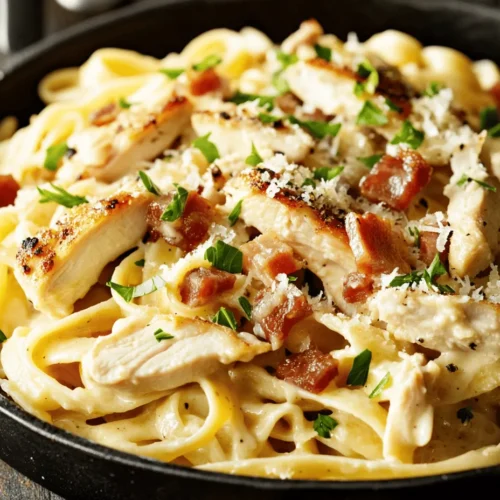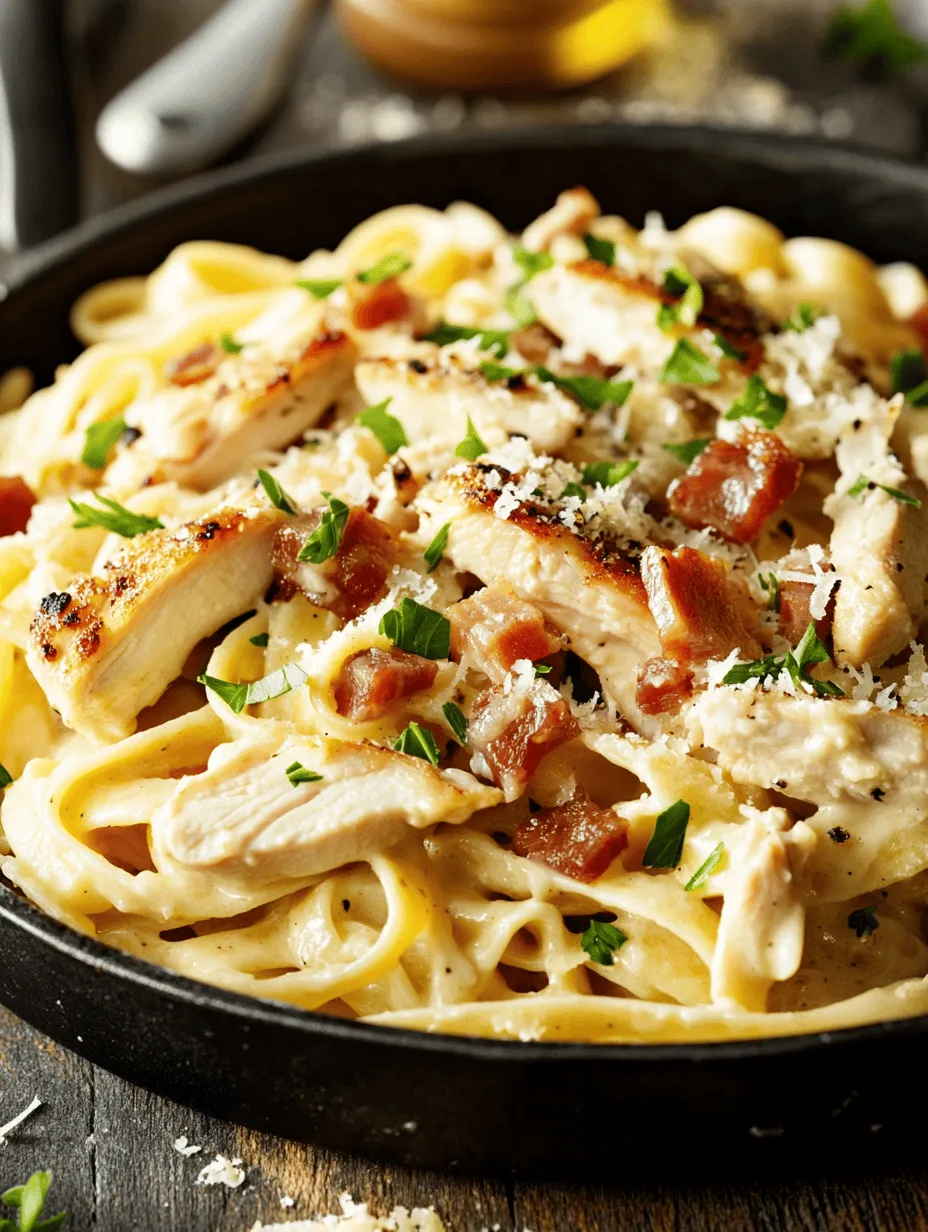Introduction
Chicken Carbonara is a delightful twist on the classic Italian pasta dish, renowned for its rich, creamy texture and robust flavors. Originating from the heart of Italy, Carbonara has evolved over the years to become a favorite not only in Italian kitchens but also in homes around the world. Its comforting nature and indulgent taste make it a staple for family dinners, special occasions, or even a cozy night in.
What sets Chicken Carbonara apart from traditional variations is its adaptability and universal appeal. While the classic Carbonara relies on guanciale (cured pork cheek) and a simple sauce made of eggs and cheese, the addition of chicken provides a leaner protein option that is both satisfying and delicious. This makes it an ideal choice for home cooks looking to please a crowd or gourmet chefs wanting to add a personal touch to a beloved classic.
Whether you’re a seasoned chef or just starting in the kitchen, Chicken Carbonara offers an inviting culinary experience that combines simplicity with elegance. The creamy sauce envelops the pasta, creating a dish that warms the soul and tantalizes the taste buds. In this article, we’ll delve into the rich history of Carbonara, explore the essential ingredients, and guide you through the preparation of this comforting dish.
Understanding Chicken Carbonara
Historical Background of Carbonara
The origins of Carbonara are somewhat shrouded in mystery, with various stories contributing to its rich culinary history. Most food historians agree that Carbonara likely emerged in the mid-20th century, with its roots in Roman cuisine. The name itself is believed to come from “carbonaro,” which translates to “charcoal burner” in Italian, suggesting that this dish may have been a favorite among coal miners in the Apennine mountains.
Traditional Carbonara is known for its simple yet flavorful ingredients: egg yolks, Pecorino Romano cheese, guanciale, and black pepper. These elements combine to create a luxurious sauce that clings beautifully to pasta. Over time, variations have surfaced, leading to the beloved Chicken Carbonara, which substitutes chicken for the traditional pork, making it a more accessible and versatile option for many home cooks.
Differences Between Traditional Carbonara and the Chicken Variation
While the classic Carbonara is celebrated for its simplicity and depth of flavor, Chicken Carbonara introduces a new layer of richness with the addition of tender, juicy chicken. The primary differences between the two versions lie in the protein source and the overall heartiness of the dish.
In traditional Carbonara, the guanciale provides a salty, savory depth that complements the creamy egg sauce. In contrast, Chicken Carbonara balances the creamy sauce with the lean protein of chicken, making it a more substantial and filling meal. This variation not only caters to those who prefer poultry but also allows for a delightful fusion of flavors that can be adapted to suit individual tastes.
Key Characteristics That Make This Dish Stand Out
What truly makes Chicken Carbonara a standout dish is its harmonious blend of flavors and textures. The creamy sauce, derived from egg yolks and Parmesan cheese, creates a luscious coating on the pasta, while the golden-brown chicken adds a satisfying bite. The combination of fresh garlic and parsley elevates the dish, providing aromatic notes that enhance the overall experience.
This recipe is also incredibly versatile—whether you prefer fettuccine, spaghetti, or even a gluten-free pasta alternative, Chicken Carbonara can be tailored to your preferences. The rich, creamy sauce pairs beautifully with various types of pasta, allowing home cooks to experiment and find their perfect match.
Ingredients Breakdown
To create the best-ever Chicken Carbonara, it’s essential to select high-quality ingredients that will enhance the dish’s flavors and textures. Here’s a closer look at the ingredients that play a vital role in this recipe.
Overview of Primary Ingredients
1. Pasta: The foundation of any Carbonara dish, the choice of pasta significantly impacts the final outcome. While traditional recipes often use spaghetti, fettuccine is a popular alternative that provides a thicker, more substantial bite. Both options work beautifully; the key is to choose a pasta that can hold onto the creamy sauce.
2. Chicken Breasts: Opt for high-quality, boneless, skinless chicken breasts for this recipe. They are lean, easy to cook, and absorb flavors well, making them an excellent choice for Carbonara. The chicken should be cooked until golden brown, adding both texture and a savory element to the dish.
3. Pancetta or Guanciale: While traditional Carbonara calls for guanciale, pancetta is a flavorful substitute that’s more widely available. Both options provide a salty, savory taste that complements the creamy sauce. If you’re looking for a healthier alternative, turkey bacon can also be used, though it will alter the flavor profile slightly.
4. Eggs and Parmesan Cheese: The creamy sauce in Chicken Carbonara relies heavily on the emulsification of egg yolks and grated Parmesan cheese. The egg yolks add richness, while the cheese introduces a nutty flavor. It’s important to use freshly grated cheese for the best results, as pre-grated varieties often contain anti-caking agents that can affect the sauce’s texture.
5. Fresh Garlic and Parsley: These ingredients bring brightness and freshness to the dish. Minced garlic enhances the overall flavor profile, while fresh parsley adds a pop of color and a burst of freshness that balances the richness of the sauce.
Fettuccine vs. Spaghetti: Which is Better for Carbonara?
The debate between fettuccine and spaghetti for Chicken Carbonara is ongoing, with passionate advocates for each side. Spaghetti, with its long, thin strands, is traditionally associated with Carbonara and allows for a delicate coating of sauce. On the other hand, fettuccine, with its wider, flat noodles, provides a heartier bite that some find more satisfying.
Ultimately, the choice comes down to personal preference. If you love the classic, go for spaghetti. If you prefer a more substantial pasta, opt for fettuccine. Regardless of your choice, ensure that the pasta is cooked al dente to achieve the perfect texture.
Importance of High-Quality Chicken Breasts
When it comes to Chicken Carbonara, the quality of the chicken is paramount. Fresh, high-quality chicken breasts yield the best flavor and texture. Look for organic or free-range chicken if possible, as these options tend to have superior taste and are free from harmful additives.
To ensure your chicken remains juicy and flavorful, avoid overcooking it. A good technique is to sear the chicken on high heat for a few minutes on each side, achieving a golden crust while keeping the inside moist. This method not only enhances the flavor but also adds a pleasing texture to the dish.
Choosing Pancetta or Guanciale: Flavor Profiles and Substitutes
As previously mentioned, traditional Carbonara uses guanciale, a type of cured pork cheek that provides an intense flavor. However, if guanciale is hard to find, pancetta is an excellent substitute. It has a similar taste profile, though it is less fatty and rich.
For those looking for a healthier option, turkey bacon can be used, but it’s important to note that it will produce a different flavor and texture. Whichever you choose, ensure it is cooked until crispy to enhance the dish’s overall taste.
Role of Eggs and Parmesan Cheese in Achieving Creaminess
The creamy sauce that makes Chicken Carbonara so indulgent is primarily created through the combination of egg yolks and Parmesan cheese. The key to achieving the perfect creaminess lies in the technique: the eggs must be tempered with the hot pasta water to prevent scrambling. This gentle cooking process allows the eggs to create a silky sauce that clings to the pasta beautifully.
Using freshly grated Parmesan cheese is crucial, as it melts more evenly and contributes to the sauce’s luxurious texture. Avoid pre-grated cheese, which often contains additives that can impact the sauce’s consistency.
The Significance of Fresh Garlic and Parsley for Flavor Enhancement
Fresh garlic and parsley are essential for elevating the flavor of Chicken Carbonara. The garlic adds a subtle depth and aromatic quality, while the parsley introduces a refreshing brightness that cuts through the richness of the sauce.
To maximize the flavor, use freshly minced garlic and coarsely chopped parsley. These ingredients not only enhance the taste but also add visual appeal, making the dish more inviting.
Step-by-Step Preparation Guide
Now that we have a solid understanding of the ingredients, let’s dive into the preparation of Chicken Carbonara. This section will guide you through the essential steps, ensuring you achieve a perfect, creamy pasta dish every time.
Cooking the Pasta
1. Salting the Water: Begin by bringing a large pot of water to a rolling boil. It’s essential to generously salt the water—aim for a taste akin to the sea. This will enhance the pasta’s flavor as it cooks.
2. Timing for Perfect Al Dente: Add your pasta of choice to the boiling water and cook it according to the package instructions until al dente. Al dente pasta should be firm to the bite but not hard. Remember, the pasta will continue to cook slightly when combined with the sauce, so it’s better to err on the side of slightly undercooked.
3. Reserving Pasta Water for Sauce Consistency: Before draining the pasta, reserve about a cup of the starchy pasta water. This water is a crucial component for achieving the right sauce consistency and helps to emulsify the sauce, creating a creamy texture.
Preparing the Chicken
1. Preparing the Chicken Breasts: While the pasta cooks, prepare the chicken breasts. Pat them dry with paper towels and season both sides generously with salt and pepper. This step is vital for enhancing the chicken’s flavor.
2. Searing the Chicken: In a large skillet, heat a drizzle of olive oil over medium-high heat. Once hot, add the chicken breasts and cook for about 5-7 minutes on each side, or until golden brown and fully cooked through. The internal temperature should reach 165°F (75°C).
3. Resting and Slicing: After cooking, transfer the chicken to a cutting board and let it rest for a few minutes before slicing it into bite-sized pieces. This resting period helps retain the juices, ensuring each bite is tender and flavorful.
With these foundational steps in place, you’re well on your way to creating a delightful Chicken Carbonara that is sure to impress family and friends alike. In the following sections, we’ll explore how to bring all these elements together into a cohesive and mouthwatering dish. Stay tuned for the next part of this culinary adventure, where we’ll dive into the creation of the creamy sauce and the final assembly of your Chicken Carbonara masterpiece.

Best-Ever Chicken Carbonara
Seasoning Tips for Maximum Flavor
To elevate your chicken carbonara to the next level, proper seasoning is crucial. Start by seasoning your chicken generously with salt and pepper before cooking. This foundational step ensures that the meat is flavorful from the inside out. Additionally, consider marinating the chicken in a mixture of olive oil, minced garlic, and fresh herbs like thyme or rosemary for about 30 minutes prior to cooking. This not only adds depth but also enhances the overall flavor profile of the dish.
When sautéing the pancetta, resist the temptation to skimp on the salt. The fat rendered from the pancetta will season the pasta and sauce beautifully, so allow it to crisp up and release its flavors. Remember, carbonara is a dish that thrives on the balance of salty, savory, and creamy elements, so taste as you go and adjust the seasoning accordingly.
Sautéing the Pancetta
Sautéing the pancetta is a critical step in achieving the distinctive flavor of chicken carbonara. Start by heating a large skillet over medium heat. Once hot, add the diced pancetta to the pan. Ensure that the pancetta is spread out in a single layer to promote even cooking and crispness.
To achieve the perfect crispness without burning, keep an eye on the heat. If the pancetta starts to brown too quickly, reduce the heat slightly. The goal is to render the fat and achieve a golden-brown color while ensuring the bits remain tender rather than overly hard. Stir occasionally, allowing the fat to coat the pan and season the other ingredients you’ll be adding later.
The Role of Garlic in Flavor Layering
Garlic is an essential ingredient in chicken carbonara that adds aromatic depth to the dish. After the pancetta has reached your desired crispness, add minced garlic to the pan. Sauté for approximately 30 seconds until fragrant, being careful not to let it burn. The sweetness of the garlic will meld beautifully with the salty pancetta, creating a complex flavor base for your carbonara sauce.
Consider using whole cloves of garlic instead of minced for a milder flavor. Sauté them whole and remove them before mixing in the sauce; this will impart a subtle garlic essence without overpowering the dish.
Mixing the Sauce
The heart of chicken carbonara lies in the creamy sauce made primarily from eggs and cheese. To prepare the sauce, whisk together large eggs and finely grated Pecorino Romano cheese in a mixing bowl. This combination provides a rich, creamy texture while ensuring the sauce clings beautifully to the pasta.
To achieve a smooth sauce, make sure to whisk vigorously until the mixture is well-combined and no lumps remain. Incorporating a sprinkle of freshly cracked black pepper into the egg mixture will add a bit of heat that will complement the other flavors in the dish.
Combining Ingredients
Once the pasta is cooked al dente, it’s time to bring everything together. Begin by draining the pasta, but save a cup of the starchy pasta water to adjust the sauce’s consistency later. Add the hot pasta directly to the skillet with the pancetta and garlic, tossing to ensure even distribution. The heat from the pasta will help to infuse the flavors of pancetta and garlic throughout.
Next, remove the skillet from the heat and quickly pour the egg and cheese mixture over the pasta, stirring vigorously to combine. The residual heat of the pasta will gently cook the eggs, creating a silky sauce. If the sauce appears too thick, gradually add some reserved pasta water until you reach your desired creamy consistency. This step is essential to achieving that perfect carbonara texture.
Creating the Creamy Sauce
Heat management is vital while creating the creamy sauce for chicken carbonara. It’s important to remove the skillet from the heat before adding the egg and cheese mixture to prevent the eggs from scrambling. The goal is to create a creamy, smooth sauce that clings to the pasta without any curdled bits.
If you notice that your sauce has started to thicken too much or isn’t as creamy as you’d like, return the pan to low heat and stir in small amounts of reserved pasta water. This will help loosen the sauce and maintain that luxurious, velvety texture that carbonara is known for.
Serving Suggestions
To present your chicken carbonara like a restaurant dish, consider the following presentation tips. Serve the carbonara in warm, shallow bowls to create an inviting dining experience. Twirl the pasta into nests using a fork or tongs for an elegant appearance. Finish the dish with a generous sprinkle of additional grated cheese, such as Pecorino Romano or Parmesan, and a light dusting of freshly cracked black pepper.
For a complete meal, consider pairing your chicken carbonara with a side of garlic bread or a fresh, crisp salad dressed in a light vinaigrette. This contrast will balance the richness of the carbonara beautifully. Additionally, a glass of chilled white wine, such as Pinot Grigio or Chardonnay, can enhance the meal’s overall experience, complementing the creamy sauce and chicken flavors.
Nutritional Information
Understanding the nutritional aspects of your chicken carbonara can help you balance indulgence with health. A typical serving of chicken carbonara contains approximately 600 calories, depending on portion sizes and specific ingredients used. The primary ingredients—chicken, eggs, and cheese—provide a good source of protein, while the pasta offers carbohydrates for energy.
While this dish is undeniably comforting, it’s essential to enjoy it in moderation. Consider using whole-grain pasta for added fiber and nutrients or incorporating more vegetables, such as peas or spinach, to boost the dish’s nutritional profile without sacrificing flavor. By balancing the indulgent elements with healthier choices, you can savor this delightful recipe guilt-free.
Conclusion
Chicken carbonara is more than just a meal; it’s a comforting dish that brings warmth and satisfaction to the table. With its rich flavors, creamy sauce, and perfectly cooked chicken, this recipe is sure to impress family and friends alike. The process of making chicken carbonara allows you to create lasting memories in the kitchen, as sharing meals is one of life’s simple joys.
We encourage you to try making this recipe at home, experimenting with flavors and techniques to make it your own. Whether it’s a weeknight dinner or a special occasion, chicken carbonara is a dish that never fails to delight. So gather your ingredients, embrace the cooking process, and enjoy the rewarding experience of creating a delicious meal that everyone will love. Happy cooking!



